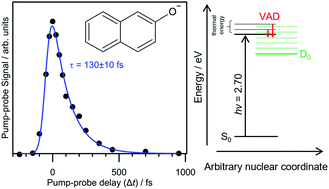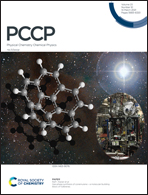Autodetachment dynamics of 2-naphthoxide and implications for astrophysical anion abundance†
Abstract
Astrochemical modelling has proposed that 10% or more of interstellar carbon could be tied up as polycyclic aromatic hydrocarbon (PAH) molecules. Developing reliable models of the interstellar carbon lifecycle requires calibration data obtained through laboratory studies on relevant chemical and physical processes, including on the photo-induced and electron-induced dynamics of potential interstellar PAHs. Here, the excited state dynamics of the S1(ππ*) state of 2-naphthoxide are investigated using frequency-, angle-, and time-resolved photoelectron imaging. Frequency-resolved photoelectron spectra taken over the S1(ππ*) band reveal low electron kinetic energy structure consistent with an indirect, vibrational mode-specific electron detachment mechanism. Time-resolved photoelectron imaging using a pump photon energy tuned to the 0–0 transition of the S1(ππ*) band (hν = 2.70 eV) and a non-resonant probe photon provides the excited state autodetachment lifetime at τ = 130 ± 10 fs. There is no evidence for internal conversion to the ground electronic state or a dipole-bound state. These results imply that 2-naphthoxide has no resilience to photodestruction through the absorption of visible radiation resonant with the S1(ππ*) band, and that electron capture by the S1(ππ*) state, which is formally a shape resonance, is not a doorway state to a stable interstellar anion.

- This article is part of the themed collections: 2021 PCCP HOT Articles and Celebrating our 2021 Prizewinners


 Please wait while we load your content...
Please wait while we load your content...